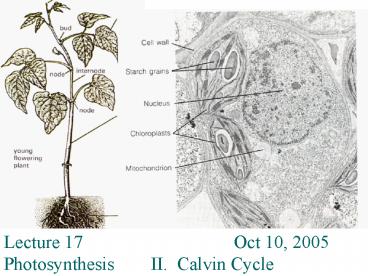Lecture 17 Oct 10, 2005 PowerPoint PPT Presentation
Title: Lecture 17 Oct 10, 2005
1
Lecture 17 Oct 10, 2005 Photosynthesis
II. Calvin Cycle
2
- Lecture Outline
- The Calvin Cycle fixes carbon
- makes reduced carbon compounds
- Reactions of the Calvin Cycle anabolic pathway
- input of NADPH H, input of ATP
- Regulation of the Calvin Cycle
- The problem with oxygen Photorespiration
- Tricks some plants use to limit photorespiration
- - C4 anatomy, C4 metabolism division of labor
- - CAM plants, the difference is night and day
3
DARK REACTIONS energy utilization The Calvin
Cycle
4
The purpose of the Carbon-fixation (Calvin Cycle)
Reactions CO2 NADPH H ATP C6H12O6
NADP ADP Pi carbohydrate
Note synthesis of carbohydrate from CO2 is
favorable only because coupled to very
favorable reactions NADPH to
NADP and ATP to ADP Pi energy released
is greater than it costs to make carbohydrate
5
- The Calvin cycle has three phases
- Carbon fixation
- Reduction (energy input, reducing equiv input)
- Regeneration of the CO2 acceptor
- (energy input priming step)
6
Overview of Carbon-Fixation Reactions
12
24
CO2
5 Carbon Sugar with 2 phosphates on it
12
24
20/24
3 Carbon Aldehyde with one phosphate on it
4/24
2
7
Carbon Fixation
Carried out by the enzyme rubisco (ribulose 1,5
bisphosphate carboxylase oxygenase)
Do need to know this enzyme Key regulatory enzyme
8
Acid -COOH
Carbon Fixation
Reduction
Rubisco
Priming Step
Aldehyde -CO H
Regenerate What started with
9
Regulation of Rubisco 1st Enzyme in Calvin Cycle
Substrate/Product availability
Allosterically regulated by NADPH and ATP
pH 8 / pH7
Very Narrow pH optimum
pH 8 or above, inactive at 7
Enzyme must be in reduced form
10
Integration of Light-Dependent and
Light-Independent Reactions They generally
occur AT THE SAME TIME
Figure 10.21
11
PhotoRespiration - the OXYGEN PROBLEM Oxygen
is a competing substrate for the 1st enzyme in
the C3 cycle (Rubisco)
Net increase in material make glucose
with extra
Energy Wasted With NO synthesis of glucose
12
Some Plants Deal with this problem by a
DIVISION OF LABOR BETWEEN CELLS C4 Plants
Mesophyll cells perform usual noncyclic
Light-Dependent Reactions make oxygen, ATP and
NADPH Do NOT perform the C3 (Calvin cycle)
reactions
Bundle Sheath cells perform UNusual cyclic
Light-Dependent Reactions a lot of ATP
but very little NADPH and very little O2
PERFORM the usual C3 (Calvin Cycle) reactions
13
- C4 leaf anatomy and the C4 pathway
Mesophyll cell
Mesophyll cell
CO2
Photosynthetic cells of C4 plant leaf
CO2
PEP carboxylase
Bundle- sheath cell
PEP (3 C)
Oxaloacetate (4 C)
ADP
NADPH used
Vein (vascular tissue)
Malate (4 C)
ATP
Malate (4 C)
C4 leaf anatomy
Pyruate (3 C)
Oxaloacetate (4 C)
NADPH regenerated
CO2
Mesophyll Produce NADPH and ATP PEP carboxylase
insensitive to O2 Malate brings across reducing
equivalents
Stomata
Bundle- Sheath cell
Cyclic e- flow Little O2
CALVIN CYCLE
Sugar
Vascular tissue
Figure 10.19
14
Mesophyll Cell C4 Metabolism
CO2
OH / CO CH2 CO CO Pi \
OH Oxaloacetate 4C acid
OH / CO CH2 H-C-O-H CO
\ OH malate 4C acid
CH3 CO CO \ O-Pi PEP
CH3 CO CO \ O-H pyruvate
carries Reducing equivalents
Needs ATP and NAPDPH H
Non-cyclic electron flow
15
Bundle Sheath - Cell C4 Metabolism
OH / CO CH2 H-C-O-H CO
\ OH malate 4C acid
OH / CO CH2 CO CO \ OH Oxaloacetate
4C acid
carries Reducing equivalents
Needs ATP Only
Cyclic electron flow Very low O2
16
Mesophyll cells provide a means for bundle
sheath cells to acquire NADPH H reducing
power Mesophyll cells provide carbon dioxide to
bundle sheath cells at higher concentration than
in air Bundle Sheath cells not making oxygen, so
very little competitor with C3 reactions
Costs more energy to do business this way but
has the advantage when CO2 is limiting (when
stomates are closed - like on hot days)
Who cares as long as the sun is shining ? ATP is
not limiting
17
CAM Plants
- Cacti, pineapple
- Open their stomata only at night, too hot during
day survive very adverse (dry) conditions
NIGHT Perform PEP carboxylase reaction at night
(CO2 assimilation) accumulate malate to high
concentration in central vacuole use sugar
oxidation/catabolism to power (NADH and ATP)
carbon fixation
DAY Perform light reactions during the day
mostly cyclic e- flow to produce ATP (low
O2) decarboxylate malate to yield CO2 and NADPH
H perform C3 reactions (Calvin Cycle) to
produce sugars and starch
18
Generally Slow growing
Sugar Oxidation Powers One Phase
Sunlight Powers Both phases
19
- Summary
- Photosynthetic light reactions produce
- ATP and reducing potential NADPH H
- 2. Dark reactions use ATP and reducing potential
- to synthesize carbohydrates
- - powers reduction of 3-carbon acid
- to 3-carbon aldehyde
- - powers regeneration of starting material
- 5-carbon di-phosphate (priming step for CO2
fixation) - 3. Rubisco enzyme regulated tightly by allosteric
modulators - pH, and reducing status of stroma
- 4. O2 interferes with carbon fixation by Rubisco
enzyme - 5. Metabolic tricks to avoid photorespiration
- - C4 metabolism - CAM metabolism

